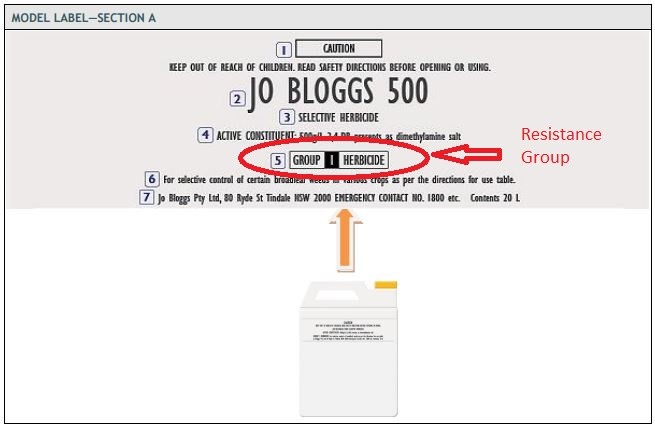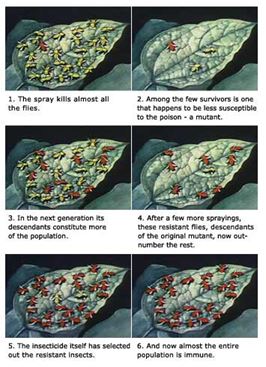How do insects become resistant to pesticide?
- Insects have an ability to develop resistance to some insecticides. Why does it happen?
- Why do some individuals have higher tolerance for insecticide?
- How do they survive poison and breed?
In this article we will try to explain how to deal with this problem and keep our chemical arsenal.
The first inkling of what the future held with respect to pesticide resistance of arthropods may be found in 1897 writings concerning control difficulties with San Jose Scale and codling moth. Between 1914 and 1946, another 11 cases of resistance to inorganic pesticides were recorded. Development of organic insecticides, such as DDT, has given little hope that insecticide resistance was an issue of the past. Unfortunately, by 1947, housefly resistance to DDT was documented. Every new insecticide group, such as cyclodienes, carbamates, formamidines, organophosphates, pyrethroids, even Bacillus thuringiensis, have developed resistance populations of insects or mites within 2 to 20 years.
The impact of this has been felt throughout the world wherever insecticides are used, in terms of increased vector-borne disease, increased pesticide hazards in the environment, crop losses and poorer quality of products, increased production costs, pest resurgences and rise of secondary pests, and various socioeconomic repercussions. Farmers in the USA lost 7% of their crops to pests in the 1940s; over the 1980s and 1990s, the loss was 13%, even though more pesticides were being used. Worldwide, more than 500 species of insects, mites, and spiders have developed some level of pesticide resistance. The two spotted spider mite is a pest of most fruit crops and is notorious for rapidly developing resistance to miticides.
The speed with which resistance develops depends on several factors:
- How fast the insects reproduce;
- Migration and host range of the pest, the availability of nearby susceptible populations;
- Persistence and specificity of the crop protection product; and
- Rate, timing and number of applications made.
Resistance increases fastest with increasing of temperature, where insects or mites reproduce quickly, there is little or no immigration of susceptible individuals and the user may spray frequently.
Pest control tactics should therefore take account of the possibility of resistance evolution. One of the best ways to retard resistance evolution is to use insecticides only when control by natural enemies fails to limit economic damage.
Repeated use of the same class of pesticides to control a pest can cause undesirable changes in the gene pool of a pest leading to another form of artificial selection, pesticide resistance. When a pesticide is first used, a small proportion of the pest population may survive exposure to the material due to their distinct genetic makeup. These individuals pass along the genes for resistance to the next generation. Subsequent uses of the pesticide increase the proportion of less-susceptible individuals in the population. Through this process of selection, the population gradually develops resistance to the pesticide.
Insecticides are organized into classes—organophosphates, carbamates, pyrethroids, neonicotinoids, etc.— that share a common chemical structure and mode of action (MOA). MOA is the specific process by which an insecticide kills an insect, or inhibits its growth.
Selection for resistance can occur if a small proportion of the insect population is able to survive treatment with insecticide. These rare resistant individuals can reproduce and pass on their resistance to the offspring. If an insecticide with the same mode of action is repeatedly used against this population, an even greater proportion will survive. Ultimately, the once-effective product no longer controls the resistant population.
Resistance may develop to only a single insecticide. However, it is more common for insects that exhibit resistance to one insecticide to be resistant (or develop resistance more rapidly) to other insecticides with the same MOA. This phenomenon is known as cross-resistance.
A closely related phenomenon, multiple resistance, occurs in insect populations that resist two or more insecticide classes with unlike modes of action. Insects develop this type of resistance by expressing multiple resistance mechanisms. This can happen if one insecticide is used until insects display a resistance and then another is used and the insect population becomes resistant to that one, and so on. Multiple resistance is less common than cross resistance but is potentially of greater concern because it drastically reduces the number of insecticides that can be used to control the insect in question.
More and more pest species are becoming resistant to pesticides at an increasing rate. For many reasons, the availability of pesticidal products that can be used in rotation against pests is decreasing. The costs of developing a pesticide (i.e., the cost of research and testing, product development, etc.) are significant. Millions of dollars are spent on chemicals that may never become marketable products. Regulatory actions have affected pesticide availability. The U.S. Environmental Protection Agency has banned and restricted many pesticides in the past two decades.
Another factor in the decreasing availability of pesticides, especially from the supply of existing pesticides, is the EPA’s re-registration of pesticides. This re-registration program often requires additional testing of pesticides to determine if their use would possibly endanger the health of humans and our environment. However, the cost of complying with EPA’s reregistration requirements for testing, plus the subsequent re-registration fees, is having a heavy impact on the current and future availability of pesticides. Many pesticide manufacturers are simply declining to re-register their products because the re-registration costs will severely reduce or eliminate potential profits from future product sales. More important, many individual active ingredients are already lost. Between pesticide cancellations and the re-registration process, whole classes of active ingredients are at risk of being lost from future use.
Resistance Management
Recommendations for successful resistance management (Modern Crop Protection Compounds, Wolfgang Kramer and Ulrich Schirmer):
- Consult a local agricultural advisor or extension services in the area for up-to-date recommendations and advice on IPM and IRM programs.
- Consider options for minimizing insecticide use by selecting early-maturing or pest tolerant varieties of crop plants.
- Include effective cultural and biological control practices that work in harmony with effective IRM programs. Adopt all non-chemical techniques known to control or suppress pest populations, including biological sprays such as Bt’s, resistant varieties, within-field refuges (untreated areas) and crop rotation.
- Where possible select insecticides and other pest management tools that preserve beneficial insects
- Use products at their full, recommended doses. Reduced (sub-lethal) doses quickly select populations with average levels of tolerance, whilst doses that are too high may impose excessive selection pressures.
- Appropriate, well-maintained equipment should be used to apply insecticides.
- Recommended water volumes, spray pressures and optimal temperatures should be used to obtain optimal coverage.
- Where larval stages are being controlled, target younger larval instars where possible because these are usually much more susceptible and therefore much more effectively controlled by insecticides than older ones.
- Use appropriate local economic thresholds and spray intervals.

To prevent the pest from building-up resistance to the chemical, you should not use chemicals from the same resistance group over and over. Swap between chemicals from different resistance groups.
- Follow label recommendations or local expert advice for use of alternations or sequences of different classes of insecticides with differing modes of action as part of an IRM strategy.
- Where there are multiple applications per year or growing season, alternate products of different mode of action classes.
- In the event of a control failure, do not reapply the same insecticide but change the class of insecticides to one having a different mode of action and to which there is no (locally) known cross-resistance.
- Mixtures may offer a short-term solution to resistance problems, but it is essential to ensure that each component of a mixture belongs to a different insecticide mode of action class, and that each component is used at its full rate.
- Consideration should be given to monitor the incidence of resistance in the most commercially important situations and gauge levels of control obtained.
- Withholding use of a product to which resistance has developed until susceptibility returns may be a valid tactic if sufficient alternative chemical classes remain to provide effective control.
A key element of effective resistance management is the use of alternations, rotations, or sequences of different insecticide mode of action classes. Users should avoid selecting for resistance or cross-resistance by repeated use within the crop cycle, or year after year, of the same insecticide or related products in the same mode of action class. Integrating non-chemical approaches such as pheromone mating disruption and cultural controls can also help delay resistance.
Consider crop residue options. Destroying crop residues can deprive insects of food and overwintering sites. This cultural practice will kill pesticide-resistant pests (as well as susceptible ones) and prevent them from producing resistant offspring for the next season. However, farmers should review their soil conservation requirements before removing residues.
By Petar Bursac, Industry Development Manager, Fruit Growers Victoria
![]()
REFERENCES:
- Andrew J. Forgash; 1984, Pesticide Biochemistry and Physiology; Volume 22, Issue 2, Pages 178-186; Symposium honouring Clyde W. Kearns, Pioneer in Insecticide Toxicology
- APVMA; 2011; Understanding Pesticide Chemical Labels; Australian Pesticides and Veterinary Medicines Authority; Kingston ACT, Australia
- Buhler, W.,: Introduction to Insecticide Resistance
- Evolution Library; Pesticide Resistance; WGBH Educational Foundation
- Gut, L., Schilder, A., Isaacs, R., McManus, P.,: How pesticide resistance develops: Fruit Crop Ecology and Management, Chapter 2: Managing the Community of Pests and Beneficials
- IRAC Online; Resistance: The Facts - History & overview of resistance
- Mallet, J.: The Evolution of Insecticide Resistance; TREE vol. 4, no. 7 1, November 1989
- Wolfgang Kramer; Modern Crop Protection Compounds, John Wiley & Sons, 2007
Disclaimer: The information contained in this publication is based on knowledge and understanding at the time of writing. However, while all reasonable efforts have been made to ensure that this information is correct and current, the information covered is subject to change. Fruit Growers Victoria Limited does not assume responsibility and hereby disclaims any express or implied liability whatsoever to any party for any loss or damage caused by errors or omissions, whether these errors or omissions result from negligence, accident or any other cause.


